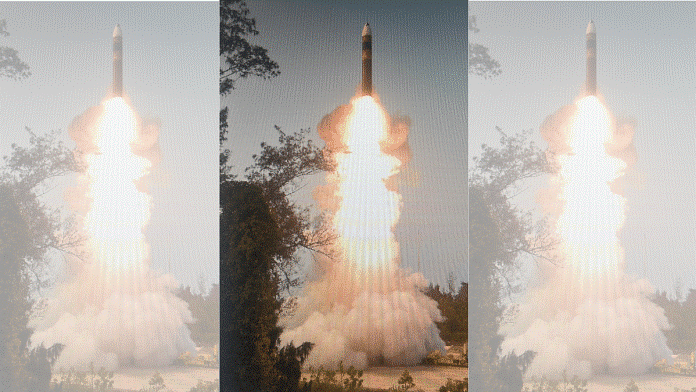Description

Disclaimer: Copyright infringement not intended.
Context
The successful launch of Mission Divyastra, announced by Prime Minister Narendra Modi, is a significant step towards India’s strategic punitive capability.
Details
Agni-5 missile
- Agni is a long-range missile developed indigenously by the Defence Research and Development Organisation, DRDO.
- The family of Agni missiles has been in the arsenal of the Indian armed forces since the early 1990s.
- This latest variant of the missile is equipped with what is known as MIRV (Multiple Independently Targetable Re-entry Vehicle) technology, first developed at least five decades ago but in possession of only a handful of countries.
- This Agni, capable of carrying nuclear warheads, has a range of more than 5,000 km, making it a long-range missile, and is aimed mainly at thwarting the challenge from China.
Agni-5 last tested
- Agni-5 has been successfully tested multiple times since 2012. In December 2022, a successful flight test of Agni-5 was undertaken off the coast of Odisha.
- Medium to Intercontinental versions of Agni missile systems 1 to 5 have varying ranges — starting from 700 km for Agni-1 to 5000 km and above for Agni-5.
- In June 2021, DRDO successfully tested Agni P, a canisterised missile with a range capability between 1,000 and 2,000 km. This means that the missile can be launched from road and rail platforms, making it easier for it to be deployed and launched at a quicker pace.
- India announced the development of Agni V in 2007, and Avinash Chander, the architect of the Agni programme who went on to head the Defence Research and Development Organisation (DRDO)

What is MIRV
- MIRVs were originally developed in the early 1960s to permit a missile to deliver multiple nuclear warheads to different targets.
- Right now, some countries are reported to have the capabilities to have a single missile carry up to 16 warheads, each in a separate re-entry vehicle.
- The MIRV can target multiple targets that can be hundreds of kilometers apart with a single missile.
- As of now, the United States, Russia, China, France and the United Kingdom are known to have MIRV-equipped missiles.
- These missiles can be launched from land or from sea from a submarine. While Pakistan is developing such a missile system, Israel too is suspected to either possess the missile or be developing it.
- Warheads on MIRVed missiles can be released at different speeds and in different directions, with such missiles capable of hitting targets as far as 1,500 km apart.
- MIRV is a complex technology because it needs a very delicate combination of large missiles, small warheads, accurate guidance, and a complex mechanism for releasing warheads sequentially during flight.
- The US was the first country to develop MIRV technology, deploying a MIRVed Intercontinental Ballistic Missile (ICBM) in 1970 and a MIRVed Submarine-Launched Ballistic Missile (SLBM) in 1971.
- The Soviet Union caught up quickly and developed their own MIRV-enabled ICBM and SLBM technology by the end of the 1970s.
|
PRACTICE QUESTION
Consider the following statements:
- Ballistic missiles are jet-propelled at subsonic speeds throughout their flights, while cruise missiles are rocket-powered only in the initial phase of flight.
- Agni-V is a medium-range supersonic cruise missile, while BrahMos is a solid-fuelled intercontinental ballistic missile.
Which of the statements given above is/are correct?
- 1 only
- 2 only
- Both 1 and 2
- Neither 1 nor 2
Answer D
|










